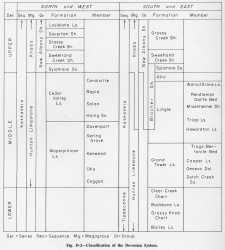New Albany Shale Group
Lithostratigraphy: Knobs Megagroup >>New Albany Shale Group
Chronostratigraphy: Paleozoic Erathem
Allostratigraphy: Kaskaskia Sequence
Primary source
Willman, H. B., Elwood Atherton, T. C. Buschbach, Charles Collinson, John C. Frye, M. E. Hopkins, Jerry A. Lineback, and Jack A. Simon, 1975, Handbook of Illinois Stratigraphy: Illinois State Geological Survey Bulletin 95, 261 p.
Contributing author(s)
Charles Collinson and Elwood Atherton
Name
Original description
The New Albany Shale Group (Borden, 1874, p. 158).
Derivation
Named for New Albany, Floyd County, Indiana.
Other names
History/background
The New Albany Shale was originally called the New Albany Black Slate. The name "Mountain Glen Shale," formerly used for the New Albany in southwestern Illinois (Savage, 1920; Weller, 1940), was replaced by "New Albany" (Workman and Gillette, 1956).
Type section
Type location
Type author(s)
Type status
Reference section
Reference location
Reference author(s)
Reference status
Stratigraphic relationships
The New Albany Shale Group is largely black shale that overlies the Sellersburg Limestone (Lingle Formation in Illinois) and is overlain by the Rockford Limestone (Chouteau Limestone in Illinois).
Extent and thickness
The New Albany Shale has a maximum thickness of about 400 feet and is exposed in western and southern Illinois.
Lithology
The New Albany Shale Group is classified as a formation in the type region (Shaver et al., 1970). It consists of the essentially continuous body of Middle and Upper Devonian and Kinderhookian (lower Mississippian) black, gray, and green shale. It includes the Blocher, Sweetland Creek, Grassy Creek, Saverton, and Hannibal Shales (figs. D-2, M-3). Lineback (1968a) differentiated the New Albany in Indiana into the Blocher Member (calcareous to dolomitic, pyritic shale rich in organic matter) at the base, the Selmier Member (greenish gray mudstone), the Morgan Trail Member (black, fissile, siliceous, pyritic shale), the Camp Run Member (alternating greenish gray mudstone and black shale), and the Clegg Creek Member (black, silty or dolomitic, pyritic shale) at the top. These units have been recognized in subsurface in eastern Illinois, but, except for the Blocher, they have not been traced widely. Black shale containing Devonian sharks' teeth has been found in crevices in the Silurian dolomite in the Chicago area (Bretz, 1939), indicating that the New Albany formerly extended across the Kankakee Arch. The New Albany has now been extended to include comparable shales in western Illinois, and the term "Champ Clark Group" used by Workman and Gillette (1956) is no longer needed for the Upper Devonian formations.
Core(s)
Photograph(s)
Contacts
Well log characteristics
Fossils
The New Albany, particularly the dark shale, contains an abundance of brown resinous spores, Tasmanites, which are called Sporangites in many reports. Conodonts are common, but normal marine macrofossils are scarce, except in a few limestone beds near the base and top.
Age and correlation
The New Albany is correlated with the Antrim and Ellsworth Shales of Michigan and the Chattanooga of Tennessee (Collinson et al., 1967a).
Environments of deposition
Economic importance
“Hardin” is an informal name applied to producing zones in the lower New Albany Shale.
Remarks
References
BORDEN, W. W., 1874, Report of a geological survey of Clark and Floyd Counties, Indiana: Indiana Geological Survey Annual Report 5, p. 134-189.
BRETZ, J. H., 1939, Geology of the Chicago region, Part 1-General: Illinois State Geological Survey Bulletin 65,
COLLINSON, CHARLES, L. E. BECKER, G. W. JAMES, J. W. KOENIG, and D. H. SWANN, 1967a, Illinois Basin, in International symposium on the Devonian System: Alberta Society of Petroleum Geologists, v. 1, p. 940-962; Illinois State Geological Survey Reprint 1968-G.
LINEBACK, J. A., 1968a, Subdivisions and depositional environments of New Albany Shale (Devonian-Mississippian) in Indiana: American Association of Petroleum Geologists Bulletin, v. 52, p. 1291-1303.
SAVAGE, T. E., 1920, Devonian formations of Illinois: American Journal of Science, v. 49, p. 169-182.
SHAVER, R. H., et al., 1970, Compendium of rock-unit stratigraphy in Indiana: Indiana Geological Survey Bulletin 43, 229 p.
WELLER, J. M., 1940, Geology and oil possibilities of extreme southern Illinois: Illinois State Geological Survey Report of Investigations 71, 71 p.
WORKMAN, L. E., and TRACEY GILLETTE, 1956, Subsurface stratigraphy of the Kinderhook Series in Illinois: Illinois State Geological Survey Report of Investigations 189, 46 p.
ISGS Codes
| Stratigraphic Code | Geo Unit Designation |
|---|---|

